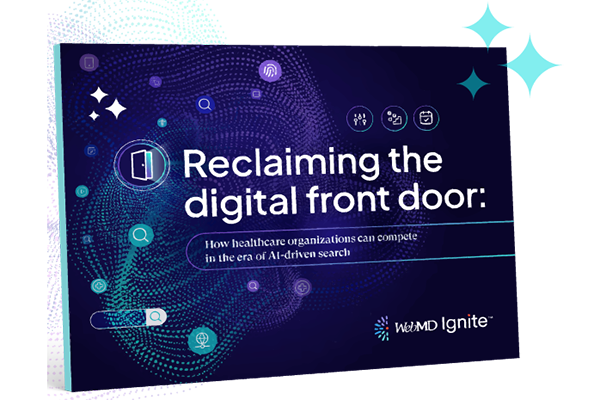7 best practices for A/B testing digital marketing in healthcare

Categories: health plans, health systems, healthcare organizations, associations
To keep pace with the rise in consumer digital media consumption, health systems are leveraging modern digital marketing tactics to supplement traditional outreach activities — with the end goal of increasing revenues through optimized relationships with prospects, patients, and physicians.
But, with healthcare marketers using so many digital tactics to connect with patients and consumers, the big question is:
How can they tell what’s actually working?
Take website optimization, for example. There are a variety of ways to evaluate the success of a health system’s website, but A/B testing is one of the most effective.
By definition, A/B testing is “a method of comparing two versions of a web page or app against each other to determine which one performs better.”
The end goal is, of course, to take the guesswork out of website optimization and enable healthcare marketers to make data-informed decisions about the type of patient communication and messaging that will have the biggest impact on their audience.
Let’s take a look at seven best practices for A/B testing website landing pages in healthcare:
- Understand the market
Before they even get started with A/B testing, digital marketers must have first developed a solid understanding of their website audience. They need to know what kind of website layout will best resonate with patients and prospects. How easy is it to read? How easy is it to relate to?
One of the best ways to find out the answers to these questions is to simply ask. A qualitative analysis can help to identify specific audience needs, leading to more detailed information for testing hypotheses. This may include, for example, using tools like Qualaroo, designed to survey website visitors for their feedback on the overall site experience (i.e., “What are the problems you are facing with the site?”).
Another tactic may involve interviewing sales or contact center representatives for information-gathering about consumer and patient problems, needs, and motivations.
- Invest in a software solution
To many marketers, A/B testing may seem like a daunting process (particularly to those new to the practice). After all, there are many different directions A/B testing can take — landing pages, search ad copy, social media, display ads, emails, etc. — and the amount of data to collect and analyze can seem overwhelming (not to mention time-consuming).
To expedite this process, it’s a good idea to invest in a software solution that can eliminate the need to A/B test manually. Enterprise-level tools such as Optimizely give organizations the ability to experiment, learn, and create optimized digital experiences across desktop and mobile devices.
- Create specific metrics
A/B testing means little if healthcare marketers have not set goals for what they wish to achieve with the testing. In other words, what are the specific metrics to be attained (website visits, time on site, etc.)?
Without these performance benchmarks, all the website changes in the world won’t lead to any kind of measurable success.
As noted by Kissmetrics, this goes beyond just having a clear idea of the results marketers are looking for with A/B testing. “You should already know your baseline result, which is the results you’re currently getting. You want to test option A and B against each other, but you also want to know that whichever one does better in the test is also doing better than your current results.”
- Start small
After outlining specific metrics to be measured, marketers will then want to begin simultaneous, controlled testing of specific variables (e.g., calls-to-action, ads, text/font, etc.).
The key is to start small — i.e., comparing one button color to another — and base tests on hypotheses (for example, “I predict a green button will get more clicks than a red,” instead of randomly changing button color).
For one client, we ran an A/B test on button color. We changed the color from blue to orange, and the client saw a 25% increase in form submits.
This goes to show that even something as simple as a color change can have significant results on lead generation.
- Take it slow
Aside from starting small, it’s equally important to avoid rushing into A/B testing. While it may be tempting to dive in head-first — after all, time is money when it comes to qualified leads and website conversions — the fact of the matter is that getting the most accurate results takes time.
Kissmetrics advises against allocating too much time to testing, however. “Giving a test insufficient time can mean skewed results…[but] running a test for too long can also give skewed results, since there are more variables you can’t control over a longer period.”
The point is to give each test sufficient time to run, giving marketers the data they need to provide the best user experience for website visitors.
- Don’t make it too noticeable
The idea with A/B testing is, of course, to optimize digital experiences for healthcare patients and consumers. But, when doing so, marketers need to be mindful of the fact that users are continuing to visit their website while the tests are ongoing.
Therefore, they need to make subtle changes that won’t be noticeable to the naked eye. Examples include swapping out an image or button color — anything that won’t change the actual framework of the landing page.
- Drive continuous improvement
When all is said and done, the goal of A/B testing is to drive the type of performance improvements that can have a significant impact over the long term. To that end, it’s critical to keep careful track of previous testing and website optimizations to build on data and analysis that can contribute to better results overall.
As noted by Optimizely, “the more tests you conduct, the longer the list of lessons becomes.”
Final thoughts
To keep pace in an increasingly competitive healthcare landscape, healthcare marketers need to be sure they’re providing the types of digital experiences patients and consumers are coming to expect — and demand.
By conducting routine A/B testing, marketers can drive website optimization that can lead to more qualified leads, improved conversions, and better patient engagement overall.




